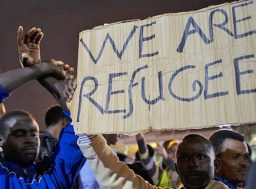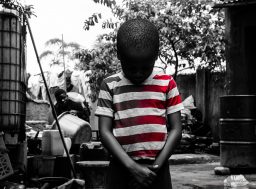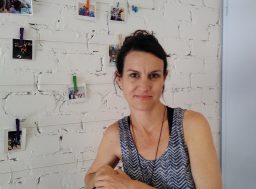
Desert Rose e.V. representative Rahel Woldemicheal had been given the opportunity to present the association and its initiative “SOS Sinai” at the Afrodonia panel discussion in 2014 on the issue “European Refugee Policies – bulwark against humanity?” Although the discussion topic was the EU’s refugee policy, the organizer considered it important and appropriate to also talk about the issue of human trafficking in Sinai on the scope of the debate.
The event was hosted by Hans Mörtter, pastor of the Luther Church in Cologne. Rahel Woldemicheal, the Head of the association Desert Rose e.V., summarized her impressions of the event once more, for everyone who unfortunately could not attend.
Sinai – dreamy beaches, desert, torture camps
„First of all I really want to thank the organizer and the audience on behalf of Desert Rose e. V. They followed the panel discussion with great interest and asked many questions. What is the life of a single human worth? The kidnapped people who are carried to Sinai, where do they come from? Etc.
The things that come into my mind when I hear „Sinai“ are dreamy beaches, sightseeing in the mountains, a whole lot of desert, torture camps, and even more desert. That’s how I describe the Egyptian peninsula at the beginning of my presentation. Then I take the audience on a journey to Sudan and to Egypt, in a truck. I try to describe to them how it might feel like to be crammed in one of those trucks, the blazing heat of the desert sun and everywhere the smell of fear, sometimes also cold fear. I tell them about the assaults, the rapes, and the punches that the kidnapped are forced to go through in the torture camps on Sinai. The youngest victim I, personally, met was at the time it was tortured only nine months old. The girl and her mother have gone through hell. Their story as well as this of three kidnapped men from Sudan I will tell you.
Pastor Mörtter: What happens to the kidnapped people after their ransom has been paid?
Well, many of them are released on the Israeli-Egyptian border after the payment of a ransom has been made. Nobody is able to say exactly how many did not get to the border because they simple did no longer have sufficient strength left. They are buried in the Sinai desert forever. Many are attacked by Israeli military and are put in so-called “Open Detention Centers”. These are facilities in the desert which are prison-like and in which the refugees have to hold out for an unknown period of time without knowing what happens to them next. Most of them have neither been visited by a lawyer nor by a doctor after they were taken into custody. Those who make it into an Israeli city by foot have no one to rely on but themselves first.
For example in Tel Aviv the Levinsky Park is the dop-in center. It’s the central place for all refugees stranded in Israel. Sooner or later, depending on which African nation they belong to, they get the necessary information to which NGO they should go to, that Sister Azezet can help with the wounds from the torture camps, that ASSAF can help with the registration, and, if possible, also provides food, that PHR-I (Physicians for Human Rights – Israel) provides the required medication, etc. Especially those, whose bodies have been crucially mutilated hope that they can find curative treatments in Israel. However, in most cases, this hope remains unfulfilled, since the Israeli community has apparently no place for people like them, black Africans, who, on top of that, also belong to a different religion.
Often about half of their body is distorted because of melted plastic and other instruments of torture or they were wounded on the border and their fellow kidnapped carried them the whole way to Tel Aviv since they did not wanted to leave them behind in the desert. In both cases the health system of Israel only treats those injuries for free that are urgent and cannot be postponed. This means that in case of a distorted body due to torture there is no action required. The victim of torture that had been wounded on the border would be hospitalized and would undergo surgery. However, as soon as the patient is awake again and is fairly able to move they put them still with their infusion needle in a taxi that takes them to one of the NGOs. The reason for this is that the hospital does not see it as an emergency anymore. It’s a really ridiculous situation if you imagine in which condition the patient is discharged from the hospital.
The patient has to pay any further treatment themselves now, for example getting stitches out or for the follow-up check. The NGOs feel left alone by the Israeli state. They barely receive financial aid also no vital support for the treatment of the injured. Everything the NGOs can do is to cooperate and work on a common list, which doctor to contact in which case and which doctors are willing to check the patients again or even operate them once more for free. There are so many cases of torture but hardly anyone is interested in them. Estimations say that there are 7,000 victims of torture in Israel. Reading doctor’s emergency reports, the word “torture” is hardly used but rather paraphrased by the injuries. It is that way because if they talk about torture the Israeli State had to acknowledge as victims of torture and had to take care of them regarding medical and psychosocial treatments. The government does not want that.
Pastor Mörtter: Which status refugees have after they are registered in Israel?
The term „Asylum seekers“ is often used, although there is no real asylum procedure as there it is for example in Germany. From the Immigration Office people receive an identity card including a visa, which lasts sometimes for a month and sometimes for six month. It seems entirely random for which period of time you get a visa or if you even get one. I told you about calls that I received from Tel Aviv at the beginning of the year. It were mostly appalled men who told me that police preyed upon them in the middle of the street. They were stopped and withheld without the police checking their documents. Many of them now either do time in the Saharonim Prison or in Holot in the Negev Desert.
It was the time when flyers were handed out in the Levinsky Park from people searching for friends, husbands or brothers. Only with time the respective community found out where the men were carried to. When I asked if they also hear of other imprisonments I got the following answer: “No, they search us blacks. They chase us because of our skin color.” Recently a Swedish woman with dark skin was arrested without a reason and the police refused to provide a lawyer. The refugee community informed lawyers specialized in Human Rights who then won the right to defend the woman. In court, the public persecution office vindicated the woman’s arrest with the suspicion that the woman intended to illicitly live in Israel and to build up a life there. The justice was highly indignant and reprimanded the public persecution office for its behavior. After that trial Israeli refugees as well as NGO employees were worried about me coming to Israel since their constitutional state showed them how dangerously far the legal interpretation is taken.
Pastor Mörtter: Weren’t you afraid of travelling to Israel despite all that is happening?
I confirm that I surely was concerned, but there are so many people that counted on me coming to Israel. How can I demand of them to have courage if I can’t work up that courage myself? Therefore, I have no other option than going to Israel again and again.
Pastor Mörtter: How can people support the work of Desert Rose e. V.?
I tell him humorously that unless you are like the action movie character Rambo it is difficult to help personally in Sinai. What we, the Israeli NGOs and Desert Rose e. V., are always happy about is when doctors agree to treat victims in their hospital. Or, when therapist specialized in post-traumatic stress disorders agree to provide aid on site for a certain period of time. Of course, we are also happy about every donation made since at the moment Desert Rose e. V. pays the majority of its actions out of its own pocket. We also always like it when German and European Media report on human trafficking in the Sinai. The torture victims may be predominantly from East Africa, however, most of the blackmailing victims live in the Western world. The highest sum paid for a single person in the Sinai that we know of is currently 80,000 USD. In this case the money came from the US. Yet the media mainly focuses exclusively on the torture of the victims because they often don’t know about the blackmailing of the victims who are often not that far away from them. This is why we try to report the number of victims of blackmailing and are thus able to put a certain pressure on the EU. Pressure towards demanding aid from the Israeli and Egyptian government for the victims of torture. Furthermore, pressure on working on a common solution for the problem in the Sinai. It would be wrong to think that human trafficking in the Sinai has nothing to do with Europe.
In conclusion I try to explain to the audience what Desert Rose e. V. thinks its role is. On site, which is in Israel, we work as therapists, social workers and also mediators in negotiations. In cooperation with other NGOs we provide educational work and do fundraising for specific projects such as the youth project of ASSAF or the women’s refuge Kuchinate. In addition, we work on gaining partners for Desert Rose e. V. and the NGOs. It is a complex work that requires a lot of sensitivity, attention, and knowledge. I add that the work should not be underestimated and you have to spend your power wisely since what you see and hear in that job definitely takes it out of you.
Author: Rahel Woldemichael, Desert Rose e.V.
Translation: Nicole Freibott/ Diana Köth/ Melanie Martin







Follow us